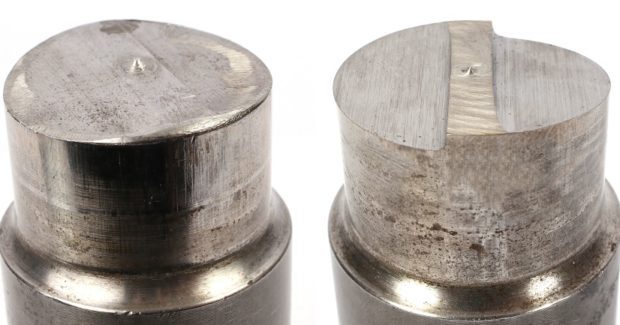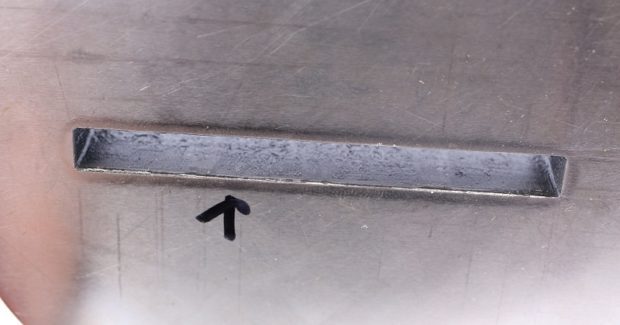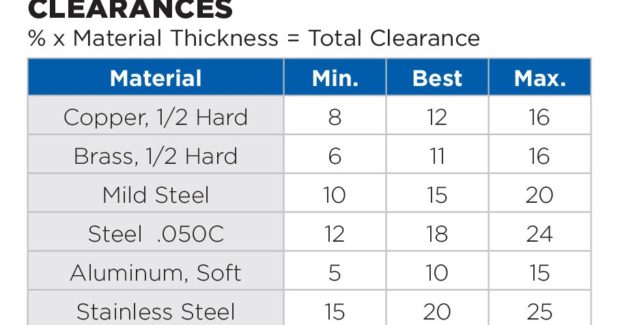Stay Sharp for Maximum Tool Life
To prevent lower quality parts and frequent tool replacement, keep your punch press tooling sharp and well maintained to achieve the greatest number of hits possible for the best possible return on your investment.
Posted: June 28, 2019
Purchasing punch press tooling for your machine is a significant, but necessary expense. Like any major purchase, you want to be sure to get the most out of your investment. In the case of punch press tooling, this means achieving the maximum number of hits possible over the life of the tool. Proper regrinding and maintenance practices are crucial to maximizing punch life and preventing problems associated with tool wear, such as unexpected replacement tooling costs, poor product quality and expensive machine downtime.
WHY REGRIND TOOLS?
Keeping tools sharp with regular regrinding is key to increasing tool life and achieving the maximum number of hits. Sharp tools not only produce a higher quality and quantity of holes, they wear much more slowly than their dull counterparts. So while it may seem counter intuitive, sharpening tools more frequently has been found to maximize tool life and improve the consistency of holes. Once tools start to wear, the wear-rate increases rapidly. The more the cutting edge breaks down, the more material will need to be removed during grinding to return it to sharp, thus shortening the life of the tool.
Example: A .040 in (1 mm) radius can develop in less than 80,000 hits, which means that .040 in (1 mm) of material has to be reground from the tool to restore sharpness.
In addition to accelerating wear and shortening tool life, dull tools create a variety of punching problems that compromise the quality and consistency of the holes. For instance, dull tools require more tonnage to punch a hole which puts unnecessary wear and tear on the punch press. When the punch press has to work harder to punch a hole, more heat is generated at the tool tip resulting in galling and stripping issues. If enough heat is generated it can affect the heat treatment on the punch tip and may result in total tool failure. Excessive wear also causes tools to behave like they don’t have enough die clearance, resulting in problems like slug pulling.
WHEN TO REGRIND TOOLS
While there is no hard-and-fast rule about how frequently tools should be reground, a good rule of thumb is to sharpen the tooling often enough so that no more than .010 in (.25 mm) material needs to be removed to completely renew the sharp edge of the punch. Keep in mind that typically the die needs to be sharpened about half as often as the punch.
Example: If a tool is sharpened every time a .010 in (.25 mm) radius develops on the cutting edge, only .010 in (.25 mm) of materials is removed from the tool to restore sharpness. Since the edge of a sharp tool breaks down more slowly, the tool lasts longer.
Three Signs Your Tool Needs Regrinding
- Feel the punch for a dull cutting edge. Experts recommend sharpening tools when the cutting edges are worn to .004 in (0.1 mm) radius.
- Watch for a deterioration in hole quality. Dull tools will increase rollover and produce excessive burrs.
- Listen to the punching noise. If the punch press is making more noise than usual, the tool’s cutting edge may need to be sharpened.
HOW TO REGRIND TOOLS
No matter what type of grinding machine you use, the grinding wheel should be dressed to present a clean, flat surface with each use to help reduce side loading, which can damage the punch assembly. Using an open, coarse, soft bond wheel (such as a Norton SGB46KVX), take light, frequent passes, removing no more than .0005 in (0.01 mm) per pass while moving horizontally on the punch or die face. Always flood the tooling with coolant while grinding. Removing more material per pass or using insufficient coolant causes heat buildup that may burn the metal and change its characteristics. This weakens the punch and leads to surface cracking, which in turn will cause the punch tip edges to wear more quickly, requiring more frequent sharpening and dramatically reducing tool life. To minimize vibrations and chatter that can further damage the tooling, punches and dies should be clamped firmly in a fixture during grinding. Using an indexible, quick-change fixture will make it easier to grind punches with shear angles.
CHECK STATION ALIGNMENT
This is one area of tooling maintenance that is often overlooked. If the punch and die are not properly aligned, tools will wear rapidly and unevenly. Before starting any new punching job, use a set of alignment tools to ensure the upper unit is aligned to the lower unit to prevent crossing, side-loading and nibbling.
USE THE CORRECT DIE CLEARANCE
Achieving the proper die clearance is another maintenance consideration that impacts both hole quality and tool life. Too much die clearance causes slugs and burrs that result in poor hole quality. Too little die clearance accelerates tool wear, creates galling, causes stripping issues, and may result in tool breakage. Determining the proper clearance for your application will depend on the material being punched. The harder the material, the greater the clearance. For thicker material, the die clearance should also be increased. Your tooling manufacturer should be able to provide you with specific clearance recommendations for your application.
Remember, punch press tooling that is not sharpened and maintained properly performs poorly, leading to high tool replacement costs. To achieve the greatest number of hits possible from your tooling and gain the best possible return on your investment, keep your punch press tooling sharp and well maintained. The alternative is punch press tooling that performs poorly, produces lower quality parts, and needs to be replaced often.














